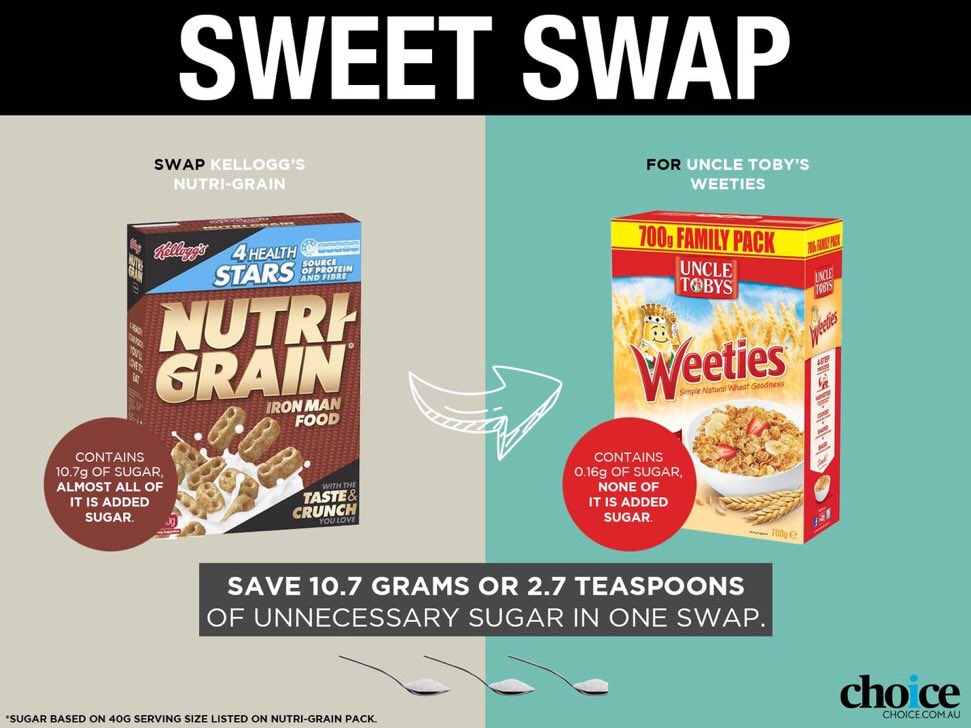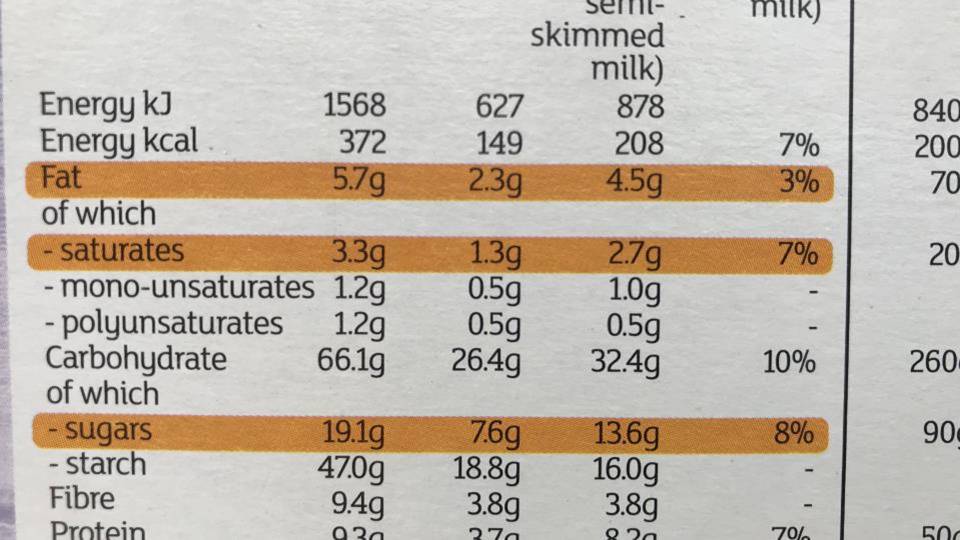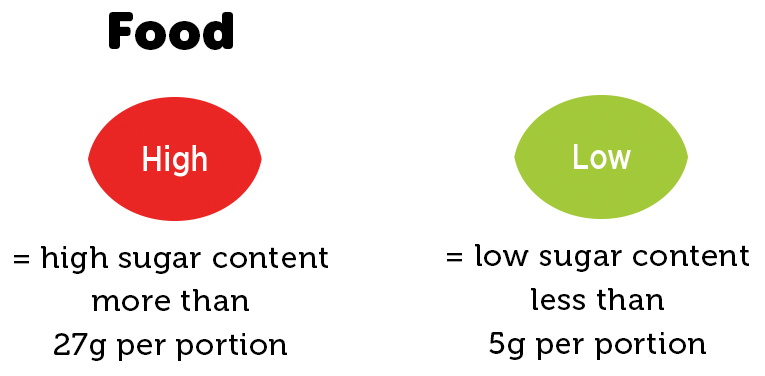43 how to read food labels for sugar content
How to understand food labels - Eat For Health The Nutrition Information Panel on a food label offers the simplest and easiest way to choose foods with less saturated fat, salt (sodium), added sugars and kilojoules, and more fibre. It can also be used to decide how large one serve of a food group choice or discretionary food would be and whether it's worth the kilojoules. Understanding Food Labels | The Nutrition Source | Harvard T.H. Chan ... Therefore, the new label shows both Total Sugar grams and Added Sugar grams. The specific types of added sweeteners will be shown in the Ingredients list. Examples: Plain dairy milk will show 12 grams of Total Sugars (naturally occurring from lactose) per cup but zero Added Sugars.
Understanding sugar content on food labels - Diabetes Care Community Reading the ingredient lists and nutrition facts tables on packaged foods is a helpful way for you to check what kind, and how much, sugar a product has. Finding sugar content in the ingredients list The ingredients are listed in order of weight, beginning with the ingredient that weighs the most and ending with the ingredient that weighs the ...

How to read food labels for sugar content
How to Read Nutrition Labels: Fat Content, Carbs & What To Look For Sugar Alcohols may be labeled simply as such or may be called out by their individual names like polyol, erythritol, sorbitol, xylitol, etc. A clue that a substance is a sugar alcohol is if it ends in "-ol". You may also see the term "allulose" listed in the carbohydrate section of a label. 8 Vital Tips To Keep In Mind While Reading Food Labels 7. Check the sodium content. Salt labeling is mandatory in the majority of countries. In many imported products, however, the label sometimes mentions 'sodium'. Now, it is important to keep in mind that salt is composed of sodium chloride. Many food companies tend to mention only the figure for sodium on food labels. › understanding-food-labelsUnderstanding food labels - Canada.ca Find information on food labels and how to understand them. Learn about nutrition facts tables, serving size, list of ingredients, % daily value and nutrition claims.
How to read food labels for sugar content. This Is How to Read a Nutrition Facts Label on the Keto Diet Some labels show both, but it's simpler to assess using the percentage figure. You may also hear about RDI (Reference Daily Intake) and DRV (Daily Reference Values), which essentially mean the same thing as Percent Daily Value [ * ]. Ingredients List The ingredient list is usually found below or next to the nutrient breakdown. Learn how to read food labels - Diabetes Care Community "Sugar" is included in the total carb count and it is the carb amount that is more important than the sugar amount. Other important nutrition facts on labels include calories, for weight management; saturated and trans fats, which raise the risk of heart disease and stroke; and sodium, for blood pressure management. › understanding-food-labelsUnderstanding food labels - Diabetes UK Check the ingredients list – if syrup, invert syrup, cane sugar, molasses or anything ending in ‘ose’ is within the first three ingredients, this suggests the food contains more added sugar. Choose an alternative if possible, or be mindful of the portion you eat. Check the fibre content on the back of pack label. If you’re choosing ... › health › how-read-food-andHow To Read Food and Beverage Labels | National Institute on ... Feb 24, 2022 · The % DV information is not calculated with the unique needs of older adults in mind. Read the nutrition label as a whole to determine how a particular food or drink fits into your healthy eating pattern. Is lower % DV always healthier? If a food has 5% DV or less of a nutrient per serving, it is considered low in that nutrient. If it has 20% ...
Fat Content on Food Labels - Reading Between the Lines The Mayo Foundation continued, "Still, you may be able to tell if a product contains trans fat, even if it's not directly listed on the food label. Look for the words ' hydrogenated ' or 'partially hydrogenated' in the list of ingredients. These terms indicate that the product contains trans fat. However, you won't be able to tell ... en.wikipedia.org › wiki › Food_energyFood energy - Wikipedia Many governments require food manufacturers to label the energy content of their products, to help consumers control their energy intake. To facilitate evaluation by consumers, food energy values (and other nutritional properties) in package labels or tables are often quoted for convenient amounts of the food, rather than per gram or kilogram; such as in "calories per serving" or "kcal per 100 ... Learning To Read Labels - Diabetes Education Online On a nutrition food label, subtract the fiber from the total carbohydrate amount. When you read food labels, the grams of sugar are already included in the total carbohydrate amount, so you do not need to count this sugar amount separately. The grams of sugar listed include both natural sugars, from fruit or milk, and added sugars. Food Labels | CDC Check the Serving size first. All the numbers on this label are for a 2/3-cup serving. This package has 8 servings. If you eat the whole thing, you are eating 8 times the amount of calories, carbs, fat, etc., shown on the label. Total Carbohydrate shows you types of carbs in the food, including sugar and fiber.
How to read food labels: MedlinePlus Medical Encyclopedia The total carbs (carbohydrates) are listed in bold letters to stand out and are measured in grams (g). Sugar, starch, and dietary fiber make up the total carbs on the label. Sugar is listed separately. All of these carbs except fiber can raise your blood sugar. How to Read a Food Label to Make Sure It's Keto in 3 Easy Steps 1. Look for a brand that indicates "No Sugar Added". Read the ingredient list to verify. Pederson's brand with the No Sugar-Whole30 Approved seal is my personal choice. 2. Go to the butcher. You can find him in the grocery store by the meat section or at your local butcher shop. Sugar Savvy: How To Read Food Labels - Elsa Jones < 5g of sugar per 100g = low sugar content. 5g - 15g sugar per 100g = medium sugar content >15g of sugar per 100g = high sugar content . Note Re. Naturally Occurring Sugars. If you're trying to calculate sugar content on a food label, it's important to bear in mind that in many cases, not all of what you see is 'added sugar'. Reading food labels: Tips if you have diabetes - Mayo Clinic Look for foods with 3 or more grams of fiber. Put sugar-free products in their place Sugar-free doesn't mean carbohydrate-free. Sugar-free foods may play a role in your diabetes diet, but remember that it's equally important to consider carbohydrates as well. A sugar-free label means that one serving has less than 0.5 grams of sugar.
Added Sugars on the New Nutrition Facts Label | FDA Single-Ingredient Sugars and Syrups Sample Label Let the Nutrition Facts Label Be Your Guide The new Nutrition Facts label can help you compare and choose foods that are lower in added sugars....

SBS Language | '43 different names for sugar': Calls for clearer food labels to avoid 'hidden ...
How to Read a Food Label | Atkins Wrong! Look carefully at the Nutrition Facts label and you will see that a single serving is calculated not as 20 ounces but as eight ounces. You are expected to share that bottle with a friend and a half! That means that all those calculations about carbohydrate content, sugar content and calories are for only eight ounces, not the whole bottle.
How to Identify Sugar on Nutrition Labels | Days To Fitness Step 3 - Compare the sugar content of similar food products. A very effective way to see how much sugar is in the food you are eating is to compare product labels side by side. For example, take a no-added-sugar cereal and a regular breakfast cereal and compare total sugar per same-sized serving. You'll often be surprised at the difference.
Sugars on food labels - Sugar Nutrition Resource Centre Sugars and the Nutrition Information Panel The Nutrient Information Panel on the back of the pack, shows detailed information on the average amount of energy, protein, fat, saturated fat, carbohydrate, sugars and sodium (a component of salt) in the food, as well as any other claim that requires nutrition information.
How to Read Food Labels and Understand Sugar Content - yum. Gluten Free The NIP on a label shows the amount of certain nutrients found in a stated amount of the product. These nutrients include energy, protein, fat (total and saturated), carbohydrate (total and sugars) and sodium. There may be further categories and/or subset of these categories, for example, 'sugars' is a subset of 'carbohydrates'.
How to Read Food Labels Without Being Tricked - Healthline This label usually means that the fat has been reduced at the cost of adding more sugar. Be very careful and read the ingredients list. Low-carb. Recently, low-carb diets have been linked to...

Denny’s Country-Fried Steak with Gravy and Bread: product description, calories, fat and sugar ...
Food labels - NHS sugars content salt content These labels provide information on the number of grams of fat, saturated fat, sugars and salt, and the amount of energy (in kJ and kcal) in a serving or portion of the food. But be aware that the manufacturer's idea of a portion may be different from yours.
kidshealth.org › en › teensFood Labels (for Teens) - Nemours KidsHealth Food labels provide more than just nutrition facts. They also tell you what's in a packaged food (i.e., the ingredients). People with food allergies need to check ingredient lists to avoid foods that can cause an allergic reaction. Some food labels also state which country the food came from, whether the food is organic, and certain health claims.
› food › new-nutrition-facts-labelHow to Understand and Use the Nutrition Facts Label | FDA manufacturers are encouraged, but not required, to use the "†" symbol immediately following the added sugars percent daily value on single-ingredient sugars, which would lead to a footnote...
How To Read Food labels for Sugar | My Sugar Free Kitchen On the label check the sugars in the nutrition panel. 5g/ml or less of sugar per 100g/ml = this would count as low sugar content. It means 5% of the ingredients are sugar Between 5g/ml and 20g/ml of sugar per 100 grams = medium sugar content. With 20ml of sugar per 100 ml, this means the product is 20% sugar…not so good.
How to read labels for added sugar - That Sugar Movement Three: Remember that 4g = 1 teaspoon of sugar. Technically, 4.2g = 1 teaspoon of sugar, but for the easy on-the-spot calculation, just remember 4g equals one teaspoon. For example, a 375ml can of Coca-Cola is about 40g of sugar. Dividing that by 4 means there are 10 teaspoons of added sugar in the one can. As mentioned above, we want to aim for ...
› how-to-read-food-labelsHow to read food labels | healthdirect In Australia, the law requires all manufactured foods to carry labels containing safety and nutrition information. This information helps you to make decisions about the food you buy and eat so you can follow a healthy diet. The label will tell you: the name of the product, describing accurately what it is. the brand name.

When reading food labels - the first ingredients listed on the label are the main ingredients ...
Reading Food Labels | ADA - American Diabetes Association The Nutrition Facts labels on foods are really the key to making the best choices. We'll cover the basics so that these labels make shopping easier for you. You've heard it all. From carb-free to low-carb, to whole and empty carbs, it's hard to know what it all means. Blood sugar highs and lows aren't always easy to understand.
› understanding-food-labelsUnderstanding food labels - Canada.ca Find information on food labels and how to understand them. Learn about nutrition facts tables, serving size, list of ingredients, % daily value and nutrition claims.
8 Vital Tips To Keep In Mind While Reading Food Labels 7. Check the sodium content. Salt labeling is mandatory in the majority of countries. In many imported products, however, the label sometimes mentions 'sodium'. Now, it is important to keep in mind that salt is composed of sodium chloride. Many food companies tend to mention only the figure for sodium on food labels.
How to Read Nutrition Labels: Fat Content, Carbs & What To Look For Sugar Alcohols may be labeled simply as such or may be called out by their individual names like polyol, erythritol, sorbitol, xylitol, etc. A clue that a substance is a sugar alcohol is if it ends in "-ol". You may also see the term "allulose" listed in the carbohydrate section of a label.











Post a Comment for "43 how to read food labels for sugar content"